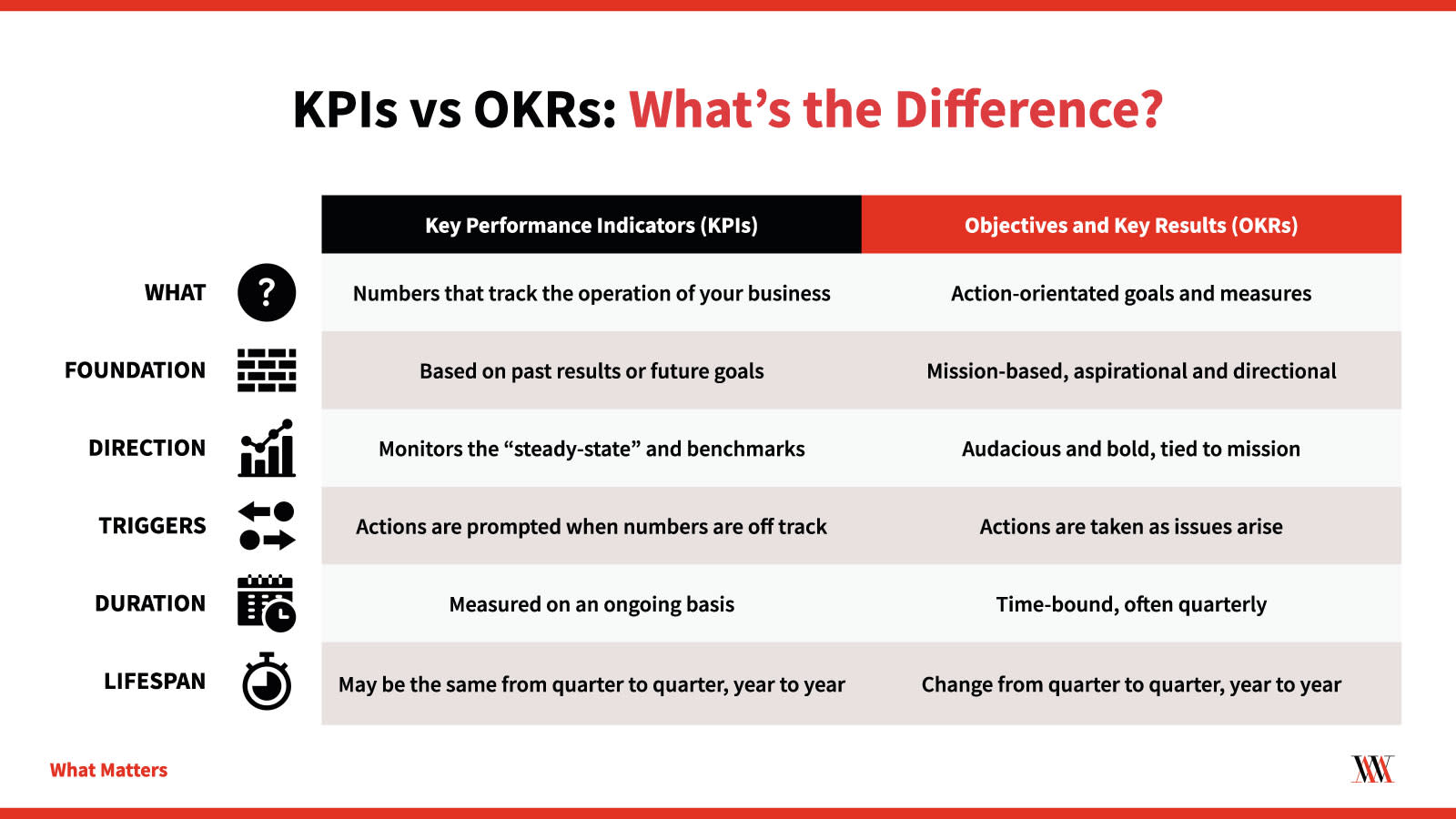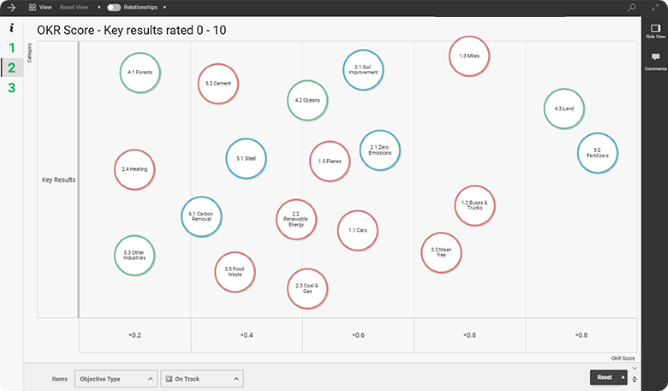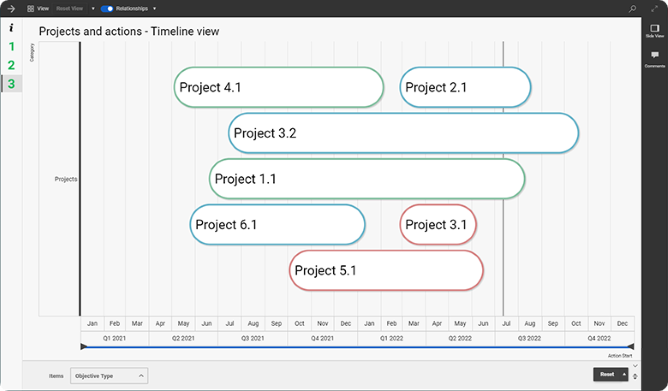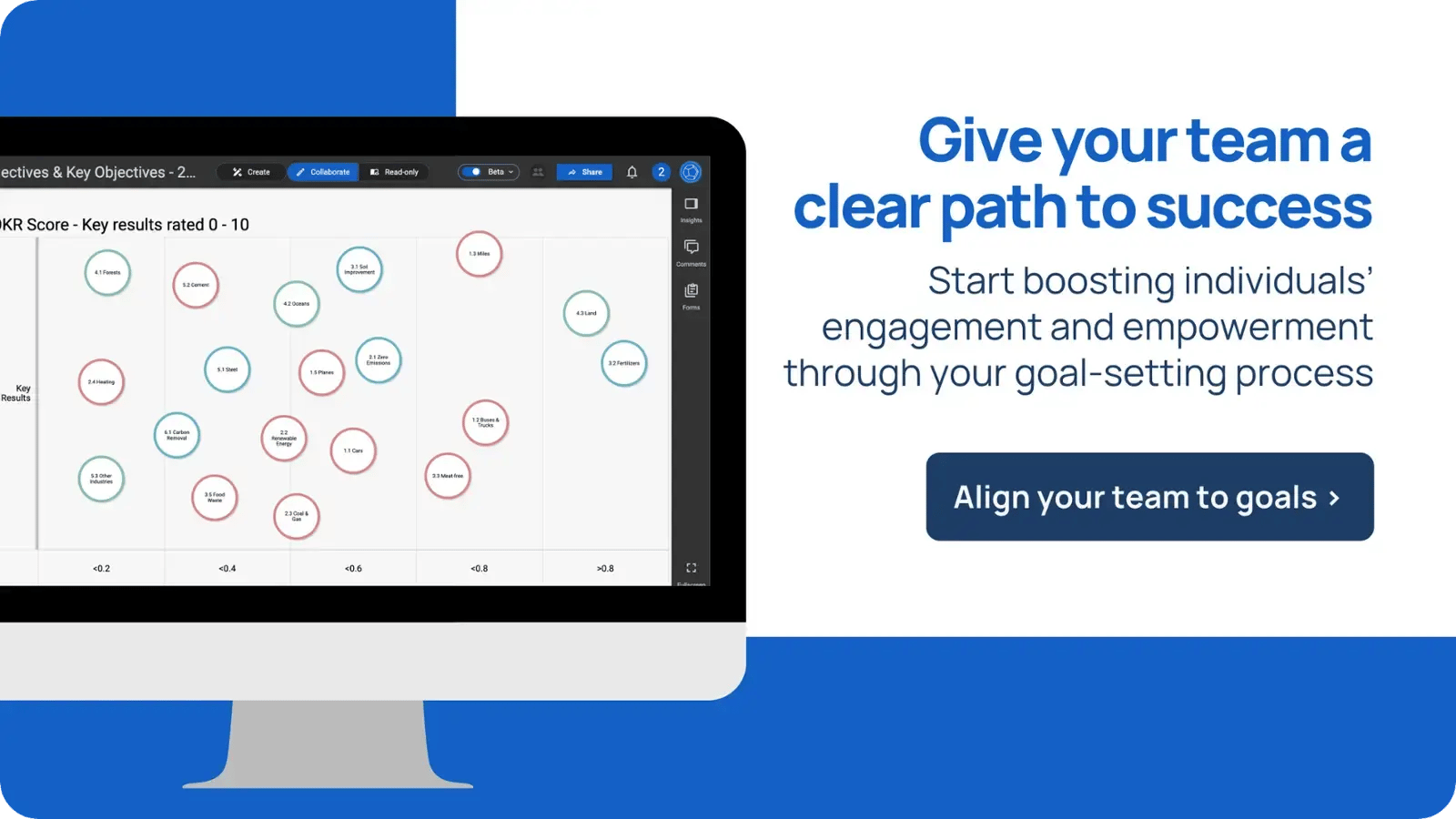"If you set a crazy ambitious goal and miss it, you'll still achieve something remarkable"- Larry Page (from Measure What Matters by John Doerr)
Most organizations are familiar with Key Performance Indicators (KPIs). KPIs can be great for measurement, but they’re standalone metrics — they may tell you when a measure is good or bad, but they don’t necessarily communicate context or what direction your team needs to go in.
If you've worked at Google, you're probably more familiar with "OKRs." OKRs, which stands for Objectives and Key Results, provide that much needed direction and context. The Objective describes what you want to accomplish and the Key Results describe how you know you’re making progress. Since KPIs are measurable, they can make great Key Results.
Read about how you can map your KPIs and OKRs in SharpCloud
What are KPIs?
KPIs are used to evaluate performance over time for an organization, individual, program, project, or action. These indicators should usually:
- Link to strategic objectives
- Direct where to focus resources
- Be measured against targets
A KPI could be any quantitative (and in rare cases, qualitative) measure a company uses to evaluate its progress and successfully reach its goals. Adding quantitative value makes it easier to provide context and compare performance for whatever you’re measuring.
KPI examples
- HR Department: attrition rate, employee performance, average recruitment time
- Sales Department: customer lifetime value, sales revenue, calls made
- Technology Industry: monthly recurring revenue, customer retention or churn, ticket resolution time
What are OKRs?
Objectives and Key Results (OKR) are a goal setting framework used in organizations across the globe. OKR has two components, the Objective and the Key Results: Objectives are memorable qualitative descriptions of what you want to achieve, and Key Results are a set of metrics that measure your progress toward the Objective.
OKRs, per CIO.com, “is a goal-setting framework that helps organizations define goals — or objectives — and then track the outcome. The framework is designed to help organizations establish far-reaching goals in days instead of months.”
OKRs were first introduced to the business world in the 1970s by the “Father of OKRs,” Andy Grove, CEO at Intel. John Doerr, the author of the New York Times Bestseller Measure What Matters, learned all about OKRs thanks to an internal class taught by Grove. In his book, he tells stories about how many large companies (Google, Netflix, Intel, Code for America, and so on) have used OKRs to grow their businesses.
OKR examples and how to write them
As Doerr outlines, OKRs must have:
A single Objective (O): The “What,” the big goal, the main thing you want to accomplish. The “O” informs your actions.
Several (often 3-5) Key Results (KRs): The “How,” the benchmarks you’ll track to meet your objective.
Doerr has some fantastic, real-life examples of OKRs here.
OKRs are:
- Always quantifiable
- Able to be objectively scored on a 0-1 or 0-100 scale
- Time- lined
- Ambitious
OKRs are built on big-picture goals and targets that are designed to push employees and companies forward, so they should toe the line of “almost impossible.” The OKR framework is a continual cycle of fast, dynamic growth.
For example:
|
Objective: Become the market leader in our industry.
|
Objective: Increase revenue by 30 percent.
|
Difference between OKRs and KPIs
So, it's clear that there is a distinguishable difference between OKRs and KPIs, namely, OKRs are a strategic framework for aligning the wider company's objectives with the nitty-gritty key results that need to be achieved and worked directly towards in day-to-day tasks.
But, do you know how OKRs and KPIs complement each other? The question isn't which is best - it's how can you best take advantage of them both. What matters is the final result, and seeing the bigger picture.
OKRs vs KPIs and how they complement each other
- As mentioned, OKR's are a strategic framework, whereas KPIs are measurements that exist within a framework. A metric, like a KPI, could be in your OKR framework. Rather than talking about OKRs or KPIs, think of them as complementary.
- If you’re looking to create a broad, high-level strategic plan, then you would use the OKR framework. If you’re looking to measure the success of a project, however, you’d use a KPI.
- KPI goals are typically obtainable and represent the output of a process or project already in place, while OKR goals are somewhat more aggressive and ambitious and are a good fit for organizations heavily focused on growth.
K is key to success
The letter 'K' in KPI — and OKR — means key: few, a handful, the most important ones.
 image by What Matters via https://www.whatmatters.com/
image by What Matters via https://www.whatmatters.com/
What makes a good KPI report?
- Keep your KPIs to a minimum. Only certain data is actually key - identify one to two KPIs per objective—measurements that will truly help you determine whether you are making progress.
- Make sure KPIs are attainable yet challenging. Employees need a target that’s motivational and makes them stretch, but one that’s too far out of reach will only serve to frustrate people.
- Be clear. Provide context for each KPI by tying it to an objective and comparing it to a target (for example, an industry average, year-over-year growth, etc.).
- Frequently review KPIs and update as necessary. Strategy meetings are a great time to reassess your performance measures. If a KPI doesn’t seem to be a good indicator of performance, or if the linked objective has changed, then you may need to adjust or retire it altogether.
- Don’t use spreadsheets to track KPIs. Unless you’re just trying out KPIs for the first time or on a trial basis, spreadsheet tracking will only make the process harder to manage.
Benefits of KPIs:
- KPIs help quickly understand complex statuses
- KPIs can be used to formulate goals and measure their implementation
- KPIs increase efficiency in communication
- KPIs provide a sound basis for decision-making
- KPIs are easy to formulate and devise
OKR planning and OKR tracking:
- Start with a few specific objectives so OKRs are easier to implement and track. You can also keep it simple by starting with enterprise-level OKRs only, and then add levels for departments (and even individuals) as you gain experience and buy-in.
- Think in the short term. OKR cycles run on a monthly or quarterly basis. So when you’re creating them, think about the goals you can reach within that time frame that will make a meaningful difference to your company.
- Make sure that executives support your OKRs. OKRs essentially outline the path your company will take to accomplish its goals. If your leadership team isn’t bought in, they won’t be walking the same path as you, which will inevitably lead to failure.
- Use strategy reporting software to simplify OKR metric tracking and reporting. Make it simple to gather data and be transparent about progress, both of which are necessary ingredients for the OKR framework to succeed.
- Don't build OKRs without visibility into what other parts of the business are doing. OKRs should be created from the top down. Start by defining your OKRs for your organization overall, and then roll them down to the department level, team level, and maybe even the individual level.
With this free OKR template, you can easily
track and manage your OKRs.
Benefits of OKRs:
-
Align and connect your employees to your corporate goals
-
Give clear direction to every team and individual
-
Increase productivity through focus on goals
-
Track regular progress towards goals
-
Make more effective and informed decisions
-
Achieve measurement, accountability, and transparency
-
Boost individuals’ engagement and empowerment through your goal-setting process
-
Increase insight and transparency across the organization for top-level executives
-
Improve resource allocation and management
-
Capture cross-functional dependencies across teams
How can SharpCloud help with tracking your KPIs and OKRs?
In SharpCloud you can easily create a dashboard that will help keep track of your company KPIs:.png?width=780&name=MicrosoftTeams-image%20(59).png)
This KPI dashboard is perfect for Project Managers (and other company leaders) to visually see a high-level overview of project KPIs — overall progress, workloads, budget tracking, time tracking, project progress, and more.
Free OKR template to drive alignment
SharpCloud offers a free OKR template solution designed to ensure alignment across all activities, map out and communicate actions that get you to the key result, and collaboratively track the status of progress.
The highest level Objectives detail the statement of intent and vision. The Key results attached to each are a stretch target for your plan. Attached to each Key Result, and shown here with relationships, are projects and other activities that will be the vehicles by which you achieve your key results.
Get started with this OKR template
Your management of these OKRs will show the score for these and interactive filters allow you to see which ones are on track, below target or above target.
How are you progressing against your OKRs?
- OKR progress here can be scored on a 0-1 basis
- See your Key Results measured on 0-1 score
- Border color shows the track status: on, below or exceeding
The filters allow you to view by sector to see OKRs for specific areas. You can size by impact, cost, or any other attribute you wish to use.

Get started with this OKR template
OKRs - Projects over time
You can run OKR's over a time period: monthly, quarterly, annually and beyond. Specific actions and projects can be connected to your OKRs and show you over time the likelihood of successful delivery so you can mitigate any concerns and make good decisions.
The border color here is shown by on track, but you can also filter by objective type to see the projects in each area.

Get started with this OKR template
We offer ways to streamline the process, including:
- Data-driven: changes to data are reflected in real-time for everyone, ensuring transparency and accountability.
- Data relationships: Complex information can be broken down and simplified using relationships, helping you to understand your data better and make smarter decisions.
- Integrations: Connect SharpCloud with the tools you already use to have all your team’s work in one place.
.jpg?width=300&name=Website_OKR.KPI%20(unsplash).jpg)
.png?width=780&name=Collaboration%20with%20SharpCloud%20(2).png)
